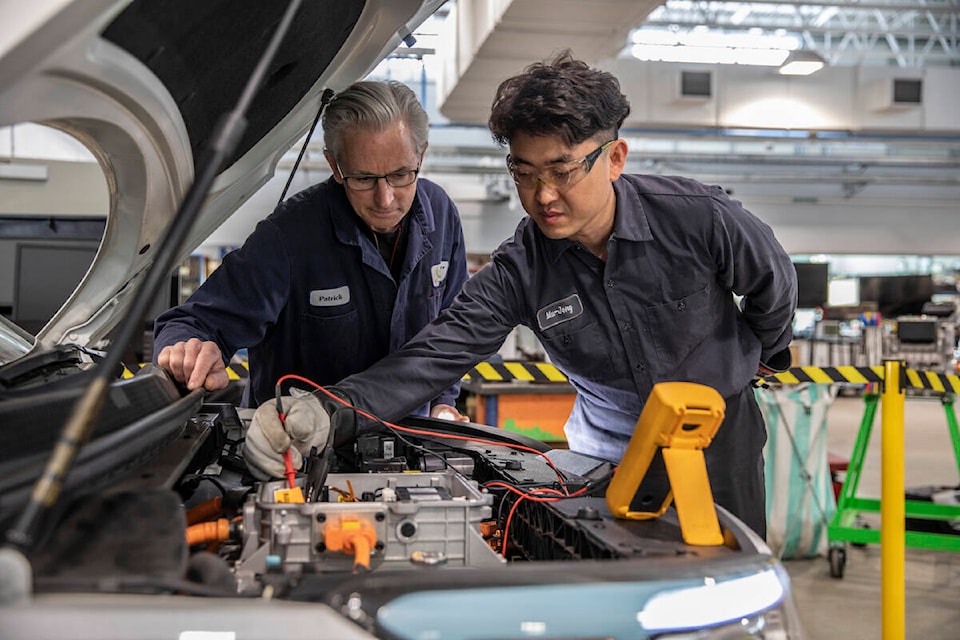Patrick Jones’ collection of classic cars includes one that’s more than 100 years old, but as someone who embraces change, he likes it when something new emerges in the automotive realm.
It’s how the award-winning B.C. automotive technician instructor got interested in electric vehicles (EVs) years ago. The performance of EVs excites him, but they also save technicians the step of venting exhaust as they work on the vehicles.
The federal government on Dec. 19 announced all cars, SUVs and light-duty trucks sold in Canada will have to be emission-free by 2035. There are challenges en route to enabling the widespread electrification of car travel in the years ahead, but Jones said he’s confident automakers will be able to deliver on the mandate and there are also some upsides.
The 2035 requirements present an opportunity for B.C.’s independent service centres as most EV work is currently done by dealerships, Jones said. It could also boost demand for converting older vehicles to electric, he said, noting he recently heard about four local vehicles that will be making the switch and he knows about several others doing the same.
“If you’ve got an older vehicle that’s got a tired gas engine, doing an electric vehicle conversion might be a sound alternative to replacing an internal combustion engine in that vehicle,” Jones said.
The pace and amount of technological change in the automotive industry is greater than ever before, Jones said. That increases the challenge for technicians who must keep evolving their understanding of complex vehicle systems.
However, the instructor said he’s not alone in wanting to work on the electric models. About 100 students have come through his program at Camosun College near Victoria. It’s a two-year-old micro-credential course, with the majority being service technicians from local shops or dealerships.
“There’s good demand out there in the trade and students seem to be very engaged when they’re in class, so they’re excited to learn about this new stuff too,” Jones said.
Prior to upgrading their skills through the college’s program, Jones said most of the technicians had no experience working with the high-voltage systems EVs use. That’s why a major part of the course deals with properly shutting down the high-voltage components so techs can safely work on the entire vehicle, while feeling comfortable doing so.
The course throws a lot of information at students over a short period as it gives in-depth know-how into battery operations and charging, temperature management systems that greatly differ from gas-powered vehicles and hybrid model transmissions that tend to be more complex.
Jones said Camosun intends to add more EV training as the micro-credential was its first offering.
He also advised the province on changes coming next year that will improve training for apprentices so that electric-vehicle education is included in their trade certification.
The instructor hopes the provincial and federal governments increase funding for schools to deliver more EV training, including how to work on electrified heavy-duty and commercial transport vehicles.
Jones noted that even in Victoria – a leader when it comes to EV adoption rates – there still needs to be many more chargers built to accommodate everyone using the emission-free rides. Victoria installed 67 electric vehicle charging stations in 2022, well short of its goal of 110.
The pace of installing charging infrastructure has been speeding up nationally as federal data shows public chargers went from under 8,000 in 2018 to 26,500 in 2023, with 40 per cent of the current total being built in 2023 alone. Research commissioned by the feds found 53,000 public chargers will be needed by 2025, before rising to about 440,000 by 2035.
Despite the obstacles, Jones said technicians have been adapting to technology advances for as long as cars have existed and he doesn’t see that changing anytime soon.
“We figure out what we need to do in order to repair the cars and keep them on the road.”
READ: Gas-powered car and truck sales done in Canada by 2035

